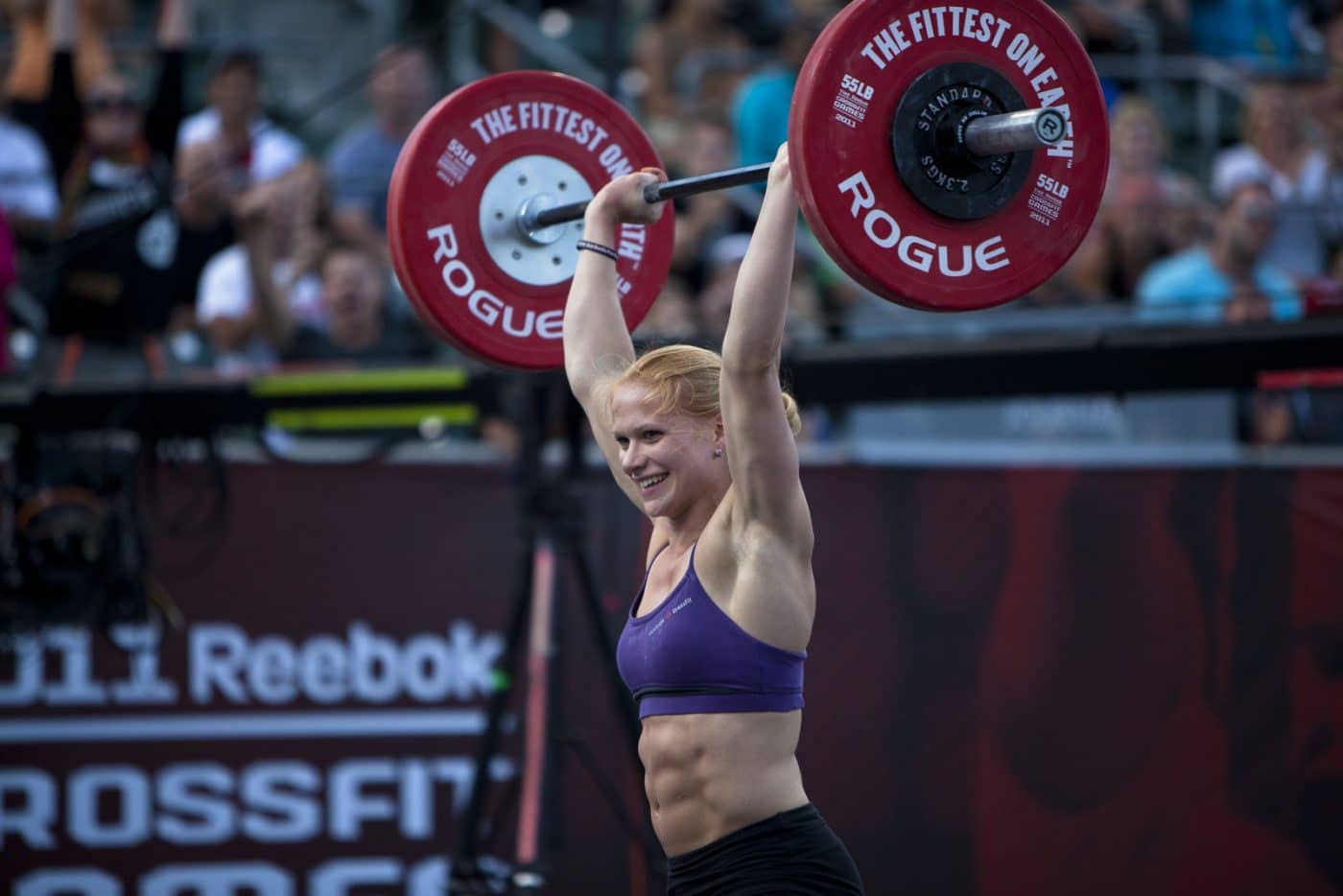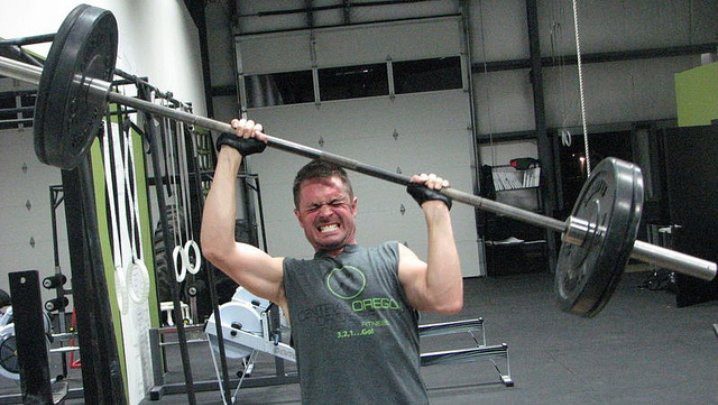
The best online fitness resource you'll ever need. We filter out the BS to ensure you meet your health and fitness goals!

The best online fitness resource you'll ever need. We filter out the BS to ensure you meet your health and fitness goals!

Like the song says – Push it real good – preferably overhead, with a barbell in your hands! The strict press and push press should both be part of a well-rounded weightlifting program. Moving weights overhead is an essential element of sports performance training, CrossFit and life! Olympic lifters, CrossFitters and fitness devotees can all reap the benefits from completing these movements, particularly with a solid understanding of the differences and the progressions.
Both the strict press and the push press are fantastic shoulder exercises, but they also offer a number of further benefits. The press is a seriously underrated compound movement that helps to develop strong shoulders, chest, core and arms while also working the rest of your body. Let’s look at the benefits in a bit more detail:
The presses are great tools for building both upper body strength and size, as a result of the large amounts of weights that can be lifted relative to total body strength. These are great exercises to help develop strength in your shoulders, rotator cuff, scapula, and upper back (amongst everything else) which plays a big role in protecting you against injury.
The push press is a movement that combines strength and power. Lower body strength combined with the ability to use power and explosivity are essential physiological qualities for most athletes. In addition, the press is a brilliant support drill for most sports where you have to transfer force from the ground through your hands – e.g. baseball, rugby or football.
Push presses are key tools for developing shoulder strength and stability necessary for more complex movements such as the jerk and the snatch. The mechanics of the hips, knees and torso during the push press are also identical to the mechanics of the jerk.
Both pressing movements work on overhead strength and stability, two elements that are vital for almost all athletes. Furthermore, better shoulder strength and stability can be of great benefit to pushing strength and resilience to injuries.
The strict press (sometimes referred to as the shoulder press) is the base movement in all overhead lifts. The objective of the strict press is to isolate your shoulders by pushing weight overhead without using momentum. The strict press stimulates the other joints in your body and is a great tool for developing overhead strength and stability.
The points of performance for the strict press:
The strict press chiefly targets the shoulders, however there are further benefits associated with this lift. All of these muscle groups are worked by strict presses.
The push press is similar to the strict press, but it brings in the lower body. You begin a push press with a dip in the legs and then shift the momentum in an upward drive that assists to push the bar from shoulders to the overhead position. The dip drive is a very rapid movement, that provides just enough momentum to get the bar moving. A push press will let you lift a lot more weight than a strict press. The addition of the hip drive makes this a full body exercise, which is a great tool for general strength development.
The push press works many of the muscles of the upper body but what differs from the strict press is that the quads and hips also play a role. The below muscle groups are targeted primarily by push presses:
The push press is a fantastic tool for working on power production, as it requires an athlete to use their legs, hips and upper body to get heavy loads overhead with speed. The push press has shown to be amazingly effective for athletes whose sport requires jumping, as this movement works on lower body explosivity. Power training is something that anyone looking to boost overall athletic performance can benefit from.
Loading, training volume, and metabolic demands targeted on a muscle all instigate hypertrophy. Both the strict and the push press work on all these aspects, so it is best to include both in a hypertrophy-based training program. The push press is great for working on power and overall loading volume, while the strict press is great for driving maximal strength and getting more time under tension.
In contrast to the push press, the strict press does not employ the lower body at all and requires the athlete to start the movement from zero acceleration, which needs a lot of concentric strength. Maximal strength is often delivered at low speeds, which means that an athlete must be able to generate large amounts of force in order to shift a rested object.
Learning the strict press is fundamental for the push press, however the push press as a movement is both complete and compound and has huge benefits. The mixture of hip explosivity, power, strength, and the capacity to transfer force rapidly is required for many sports. The strict press too has great benefits, but the added hip drive combined with the ability to move greater loads makes the push press the better choice for all round athletic performance.
From an athletic standpoint, the key role of the abs is midline stabilization, not flexion of the trunk. The core is essential for swimming, cycling, jumping and running, but their role as stabilisers is particularly important when it comes to driving weights overhead.
It goes without saying that the heavier the weight, the more significant the core’s role becomes. It is clear to see when an athlete is not correctly engaging the core in an overhead lift – the body begins to arch and pushes the hips in front of the bar.
This is where athlete’s must be very careful and attentive that they do not let this happen. Perform core activation exercises to aid in stabilizing the midsection and prevent injury.

Overhead presses can be one of the most challenging movements for beginners to conquer. Without careful attention to form, it can be relatively easy to displace power and strength. As the loads begin to increase these challenges become greater. Here are a few common mistakes and some tips for fixing them (these apply to both strict and push press):
The press should be a vertical movement, directly over the spine. For a good movement, in the lockout position of the bar the joints should all be aligned to create the most efficient position.
Poor bar path can cause several problems. To begin with, a bar path that is not vertically aligned with the athlete’s centre of gravity cause them to lose their balance, and in turn their ability to stay strong beneath the bar. It will also put unnecessary load on the shoulders and back.
The Fix: Recording your press from a side-view can be a great tool in order to see the trajectory of the bar. Ideally, the bar should finish overhead between the middle of your foot and your heel. Poor bar path can often be caused by lack of shoulder mobility. If mobility is lacking it often translates into poor movement mechanics.

Unlike the bench press, a notable back arch is not beneficial for the overhead press. The force of the weight is being loaded directly over your spine, and an excessive arch can cause back pain. If you have a marked back arch when pressing overhead, try these three training tweaks:
When lifting (and this applies to any lift) you should be working with a weight that you can lift with correct form for the prescribed number of repetitions. If you find yourself struggling to get the weight overhead, you are setting yourself up for a mess! You will compensate in any way necessary to get the bar overhead: pitching forwards, falling backwards, using momentum to drive the barbell up while simultaneously pushing it away from your body and so on. Form must always come first.
The Fix: The push press must not be thought of as a traditional strength drill, but a power move. When power is the goal, speed is imperative. If you load up with too much weight, this will slow you down, which is counterproductive for building power.
You cannot reap the benefits of a movement if you are not working through the full range of the exercise. To fully execute an overhead press your arms need to be locked out at the top of each rep, with the barbell directly over your head. When lowering the barbell back down, it should come all the way down and finish at the top of your chest.
Fix it: Mobility will often play a role in range of motion. Work on gaining more mobility through your shoulders.
If you have a desk job and struggle to get your arms overhead, you are by no means a minority. Warming up properly before working on overhead lifts is key. Sitting in a chair all day will cause your shoulder to round forward, which brings your scapula’s forward and causing forward flexion of the thoracic spine. The overhead press works on the total opposite of these movements, so a good warm up will go a long way to achieving better range of motion, better technique and will serve to help avoid injuries.
Fix it: Take some time to warm up correctly, stretch and mobilize the shoulders and back before performing any overhead press.